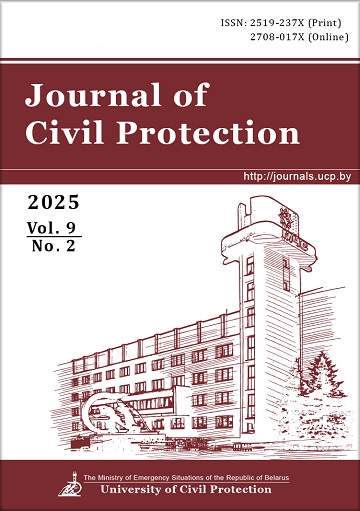Chemical fire and explosion hazards at seaports: a review of human – causes, consequences and prevention strategies
DOI:
https://doi.org/10.33408/2519-237X.2025.9-2.203Keywords:
chemical fire, chemical explosion, seaport, hazard, risk, prevention, Human Factor Analysis and Classification System (HFACS)Abstract
Purpose. Seaports serve as critical centers for global trade and transportation; however, they are also prone to significant risks of chemical fire and explosion accidents. The purpose of this paper is to examine the human-related causes, consequences, and prevention strategies associated with these hazards at seaports, while addressing their potential to cause severe casualties, environmental harm, economic losses, and social disruption.
Methods. This study is based on an analysis of major historical and recent incidents of chemical fires and explosions at seaports. Through this review, the paper evaluates the contributing human factors, the resulting impacts, and the strategies employed to mitigate such risks, while also exploring challenges and opportunities for enhancing safety management of hazardous chemicals.
Findings. The findings highlight that chemical fire and explosion accidents at seaports lead to significant consequences, including loss of life, environmental damage, and economic and social setbacks. The paper identifies key prevention strategies and discusses the need for improved safety management practices. In conclusion the recommendations for future research and practical measures to strengthen the handling and safety of hazardous chemicals at seaports are offered.
Application field of research. Safety management of hazardous chemicals in seaports.
References
Galieriková A., Dávid A., Materna M., Mako P. Study of maritime accidents with hazardous substances involved: comparison of HNS and oil behaviours in marine environment. Transportation Research Procedia, 2021. Vol. 55. Pp. 1050–1064. DOI: https://doi.org/10.1016/j.trpro.2021.07.182.
Review of Maritime Transport: United Nations Conference on Trade and Development (UNCTAD). United Nations, Geneva, 2019. 132 p. ISBN 978-92-1-112958-8.
Tang X., Dziemińska E., Koichi Hayashi A., Tsuboi N. Numerical investigation of three deflagration-to-detonation transition conditions related to the velocity of the spontaneous reaction wave. International Journal of Hydrogen Energy, 2021. Vol. 46, No. 75. Pp. 37487–37501. DOI: https://doi.org/10.1016/j.ijhydene.2021.09.055.
Shijie L. Combustion, Reactive Hazard, and Bioprocess Safety. Bioprocess Engineering: Kinetics, Sustainability, and Reactor Design, 2017. Chapter 18. Pp. 1059–1128. DOI: https://doi.org/10.1016/b978-0-444-63783-3.00018-6.
Zhang Y., Guo W., Sun C., Jing L. Systems-based Analysis of China-Tianjin Port Fire and Explosion. Ekoloji, 2019. Vol. 28, No. 107. Pp. 1921–1928. Available at: https://www.researchgate.net/publication/336413178_Systems-based_Analysis_on_the_China-Tianjin_Port_Fire_and_Explosion (accessed: January 15, 2024).
El Zahran T., Geha M., Sakr F., Bachir R., El Sayed M. The Beirut Port Blast: spectrum of injuries and clinical outcomes at a large tertiary care center in Beirut, Lebanon. European Journal of Trauma and Emergency Surgery, 2022. Vol. 48. Pp. 4919–4926. DOI: https://doi.org/10.1007/s00068-022-02023-9.
Lower M. Magott J., Skorupski J. A System-Theoretic Accident Model and Process with Human Factors Analysis and Classification System taxonomy. Safety Science, 2018. Vol. 110. Pp. 393–410. DOI: https://doi.org/10.1016/j.ssci.2018.04.015.
Happell S., Wiegmann D. Applying reason: The human factors analysis and classification system (HFACS). Human Factors and Aerospace Safety, 2001. Vol. 1. Pp. 59–86.
Zhou L., Fu G., Xue Y. Human and organizational factors in Chinese hazardous chemical accidents: A case study of ‘8.12’Tianjin Port fire and explosion using the HFACS-HC. International Journal of Occupational Safety and Ergonomics, 2017. Vol. 24, No. 3. Pp. 329–340. DOI: https://doi.org/10.1080/10803548.2017.1372943.
Tianjin explosions: warehouse 'handled toxic chemicals without licence' – reports. Available at: https://www.theguardian.com/world/2015/aug/18/tianjin-blasts-warehouse-handled-toxic-chemicals-without-licence-reports (accessed: August 18, 2024).
Fu G., Wang J., Yan M. Anatomy of Tianjin Port fire and Explosion: Process and Causes. Process Safety Progress, 2016. Vol. 35, No. 3. Pp. 216–220. DOI: https://doi.org/10.1002/prs.11837.
Chen Q., Wood M., Zhao J. Case study of the Tianjin accident: Application of barrier and systems analysis to understand challenges to industry loss prevention in emerging economies. Process Safety and Environmental Protection, 2019. Vol. 131. Pp. 178–188. DOI: https://doi.org/10.1016/j.psep.2019.08.028.
Zhang Y., Jing L., Sun C. Systems-Based Analysis of China-Tianjin Port Fire and Explosion: A Comparison of HFACS, AcciMap, and STAMP. Journal of Failure Analysis and Prevention, 2018. Vol. 18. Pp. 1386–1400. DOI: https://doi.org/10.1007/s11668-018-0534-1.
Martin D., Tomida M., Meacham B. Environmental impact of fire. Fire Science Reviews, 2016. Vol. 5. Article 5. 21 p. DOI: https://doi.org/10.1186/s40038-016-0014-1.
Small R.D. Environmental impact of fires in Kuwait. Nature, 1991. Vol. 350. Pp. 11–12. DOI: https://doi.org/10.1038/350011a0.
Kajitani Y., Cruz A.M., Tatano H., Nakano K., Choi J., Yasuda N. Economic impacts caused by the failure of a maritime global critical infrastructure: the case of the Malacca and Singapore Straits. Journal of Transportation Security, 2013. Vol. 6. Pp. 289–313. DOI: https://doi.org/10.1007/s12198-013-0117-z.
Barnes G., Baxter J., Litva A., Staples B. The social and psychological impact of the chemical contamination incident in Weston Village, UK: a qualitative analysis. Social Science & Medicine, 2002. Vol. 55, No. 12. Pp. 2227–2241. DOI: https://doi.org/10.1016/S0277-9536(01)00367-7.
Rábade J., Aragoneses C. Social Impact of Large-Scale Forest Fires. Proc. of the Second International Symposium on Fire Economics, Planning, and Policy: A Global View, Albany, California, April, 2008. United States Department of Agriculture, Forest Service, Pacific Southwest Research Station. Ed. by: A. González-Cabán. Albany, 2008. Pp. 23–33.
Ramamurthy A. Mongolia: Improving the Management of Hazardous Chemicals. Asian Development Bank. Philippines, 2019. A vailable at: https://coilink.org/20.500.12592/fn5gxv (accessed: January 15, 2024). CID: 20.500.12592/fn5gxv.
OECD Guiding Principles for Chemical Accident Prevention, Preparedness and Response: Guidance for Industry (including Management and Labour), Public Authorities, Communities, and other Stakeholders. Paris: OECD Publishing, 2003. 190 p. (OECD Environment, Health and Safety Publications. Series on Chemical Accidents, No. 10). DOI: https://doi.org/10.1787/9789264101821-en.
A flexible framework for addressing chemical accident prevention and preparedness: A Guidance Document. United Nations Environment Programme, 2010. 188 p. ISBN: 978-92-807-3094-4.
Your steps to chemical safety: A guide for small business. Health and Safety Authority, 2011. 36 p. ISBN: 978-1-84496-147-4.
Published
How to Cite
License
Copyright (c) 2025 Ngo V.N., Nguyen H.H., Phan A.

This work is licensed under a Creative Commons Attribution-NonCommercial 4.0 International License.




















